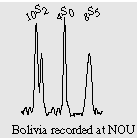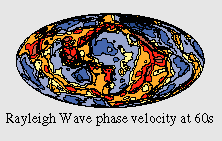Surface Wave Dispersion maps
These are examples of data sets that could constrain the 3D short-wavelength
structure of the new 3D reference model. Such maps are composed at various
frequencies and are then inverted for 3D mantle structure. There is general
agreement about the location of long-wavelength structure. But the small-scale
features still vary considerably from author to author.
Surface wave maps of various work groups are shown at two periods:
150s/6mHz and 50s/12mHz (frequencies are chosen to allow a qualitative
comparison). Anomalies are percentage phase velocity perturbations.
The signal in the shorter period maps is usually larger
than in the longer period ones, indicating that 3D structure is
concentrated at shallower depth. The maps are expanded in surface spherical
harmonics where the truncation level is indicated in the table below.
| Rayleigh wave maps |
 |
| Love wave maps |

|
Amplitude spectra
 The spectra are shown only up to harmonic degree l=24. They are normalized so
that the spectrum of a delta-function would be flat.
While the long-wavelength patterns generally agree in phase, there is still some
disagreement in the spectral amplitude. The maps with low amplitudes at harmonic
degrees 1-5 are inconsistent with our (L&M) phase data. The ones with high
amplitudes at high harmonic degree (rough maps) cannot explain our polarization data
(which are particularly sensitive to short-wavelength structure).
The spectra are shown only up to harmonic degree l=24. They are normalized so
that the spectrum of a delta-function would be flat.
While the long-wavelength patterns generally agree in phase, there is still some
disagreement in the spectral amplitude. The maps with low amplitudes at harmonic
degrees 1-5 are inconsistent with our (L&M) phase data. The ones with high
amplitudes at high harmonic degree (rough maps) cannot explain our polarization data
(which are particularly sensitive to short-wavelength structure).
Contributors
G. Ekström, J. Tromp and E. Larson, Measurements and global models of surface
wave propagation.
J. Geophys. Res.,102, 8137-8157, 1997.
G. Laske and G. Masters, Constraints on global phase velocity maps from
long-period polarization data.
J. Geophys. Res.,101, 16,059-16,075, 1996.
J. Trampert and J.H. Woodhouse, High-resolution global phase velocity
distributions.
Geophys. Res. Let.,23, 21-24, 1996.
J.P. Montagner and T. Tanimoto, Global anisotropy in the upper mantle inferred from
the regionalization of phase velocities.
J. Geophys. Res.,96, 20,337-20,351, 1991.
Y.-S. Zhang and T. Lay, Global surface wave phase velocity variations.
J. Geophys. Res.,101, 8415-8436, 1996.
|



